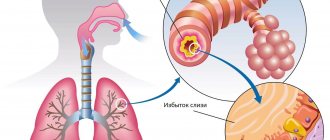How to treat bronchitis?
August 6, 2021
13580
4.5
2
Content
- Symptoms of bronchitis
- Symptoms of acute bronchitis
- Symptoms of chronic bronchitis
- Why does bronchitis occur?
- Top 6 best medicines for bronchitis
- Bromhexine
- Dr. MOM
- ACC
- Ascoril
- Atrovent
- Salbutamol
With bronchitis, the inner lining of the bronchi becomes inflamed, causing a person to have a cough and breathing problems. Bronchitis is treated by a pulmonologist or otolaryngologist.
What forms are there?
Symptoms and treatment of chronic bronchitis depend on how the disease progresses in a particular patient.
The acute form develops very quickly and is characterized by a rapid course and severity of symptoms. Chronic bronchitis most often becomes the result of an untreated acute disease or occurs due to prolonged exposure to provoking factors (for example, smoking or smoke in the atmosphere in a metropolis). The manifestations of the chronic form of bronchitis are more smoothed out, and the course has periods of exacerbation and remission.
Symptoms of bronchitis
The main sign of bronchitis is a cough, and at first it is dry, unproductive, and later it becomes wet and sputum begins to come out. The bronchial mucosa is swollen, the lumen of the respiratory tract narrows - hence the cough and difficulty breathing. The swollen mucous membrane begins to secrete more secretions - a cough with sputum appears. Bronchitis in adults and children can be acute or chronic, with symptoms varying in different cases.
Read also How to treat dry cough: top 5 drugs The best drugs for dry cough in adults.
Symptoms of acute bronchitis
The doctor makes the diagnosis of “acute bronchitis” based on the following symptoms:
- severe coughing attacks;
- chest pain when breathing;
- wheezing;
- shortness of breath during physical activity, and sometimes even at rest;
- fatigue, apathy and weakness;
- increased sweating;
- chills and increased body temperature (within 38-38.5 degrees).
Symptoms of bronchitis
Photos from open sources
Acute bronchitis is usually easy to catch in winter, when the immune system is weakened. Often acute bronchitis at the onset of the disease is similar to a cold. When a dry cough turns into a wet one, with the release of a large amount of sputum, bronchitis can be suspected. If bronchitis is catarrhal, the sputum is usually yellowish or whitish. If purulent inflammation actively develops in the bronchi, the sputum will be green.
Sometimes acute bronchitis also affects the upper respiratory tract: the mucous membranes of the trachea, pharynx or nose - an inflammatory process also develops here. Typically, the peak of acute bronchitis occurs on the 3-4th day of illness and over time the symptoms of bronchitis subside. If adequate treatment for uncomplicated acute bronchitis is started in time, the patient will fully recover within 7-10 days.
Symptoms of chronic bronchitis
Chronic bronchitis is a long-term disease, with exacerbations occurring from time to time. Chronic bronchitis can be provoked by the same factors as acute bronchitis. The clinical manifestations of chronic bronchitis are similar to those of acute bronchitis. During remission, a person may experience shortness of breath, even if he exerts little physical activity. Such shortness of breath during bronchitis is caused by the fact that the bronchial mucosa is constantly inflamed - they allow less air to pass through than healthy ones. This condition is called chronic obstructive bronchitis (COB).
COB is dangerous for young children whose lung capacity is physiologically small. Problems with air flow in a child provoke a deterioration in gas exchange throughout the body. This provokes a lack of oxygen in organs and tissues, resulting in organ malformations, cardiopulmonary failure and disability. The body tries to establish normal gas exchange in the lungs by expanding the end sections of the respiratory tree - emphysema develops. Therefore, if a child has a similar pathology, it is necessary to urgently begin treatment.
Treatment in adults
For viral bronchitis, antibiotics and sulfa drugs are not prescribed. If bronchitis is of a bacterial nature with mucopurulent sputum, symptoms of intoxication, broad-spectrum antibacterial drugs are prescribed; the most pronounced and rapid effect is achieved by intramuscular or intravenous administration of the drug. Source: Important features of the treatment of acute bronchitis. Ignatova G.L., Belevsky A.S. Practical pulmonology, 2021. p. 80-84.
The effectiveness of antibacterial therapy in the treatment of acute bronchitis increases significantly when combined with intravenous laser blood irradiation (ILBI). This technique has a beneficial effect on the rheological properties of blood (improving peripheral blood supply, reducing thrombus formation), enhances the bactericidal activity of plasma, and also activates the immune system and antioxidant defense. Physiotherapy for acute bronchitis and non-drug treatment are also indicated. Source: Pharmacotherapy of acute bronchitis: setting priorities. Zaitsev A.A., Budoragin I.E., Isaeva E.I., Vetrova E.I., Tyusheva V.V., Ivanova N.A. Antibiotics and chemotherapy, 2021. p. 44-49.
To sanitize the bronchial tree, administration of drugs by inhalation using a nebulizer is indicated.
Why does bronchitis occur?
There are three main groups of causes for the development of bronchitis
.
Infections:
- viruses (influenza, adenovirus);
- bacteria (streptococci, pneumococci, staphylococci);
- atypical microorganisms (chlamydia or mycoplasma);
- fungal infections.
Chemical irritants:
- polluted air of industrial cities;
- smoke or dust in the air;
- fumes hazardous to health;
- smoking.
Internal reasons
First of all, these are allergic reactions to various substances, which cause inflammation of the bronchial mucosa. Cardiovascular diseases and lung diseases, infections of the nasopharynx, oral cavity and tonsillitis can also cause the development of bronchitis.
Causes of acute bronchitis
Photos from open sources
Heart failure
Every minute in Russia one person with chronic heart failure (CHF) dies. This complication is detected in many diseases and vascular accidents, notes Arkady Vertkin. According to statistics, more than 12 million people with this pathology are registered in Russia. 92% of patients in cardiology departments are hospitalized due to decompensation of chronic heart failure. It is important to note, the professor says, that cough and shortness of breath may be the first signs of CHF.
Symptoms:
- dry cough, combined with increasing shortness of breath;
- increased cough during physical activity, in a horizontal position, at night;
- “bubbling” breathing;
- symmetrical swelling of the lower extremities, palpitations, a feeling of interruptions in the functioning of the heart;
- orthopneic position.
A history of diseases of the cardiovascular system, including a previous myocardial infarction, coronary artery stenting, coronary artery bypass grafting, atrial fibrillation, as well as the presence of background pathology (arterial hypertension, diabetes mellitus and obesity) will help recognize this complication, the specialist warns .
Gastroesophageal reflux disease: how to prevent exacerbation Read more
Bromhexine
The main advantages of this remedy for bronchitis are its affordable price, complex effects and the absence of side effects. "Bromhexine" copes well with a productive, wet cough. The drug for bronchitis can be bought at the pharmacy in the form of tablets and syrup. "Bromhexine" reduces the viscosity of sputum and improves its discharge. But do not expect an immediate effect from the drug - the therapeutic effect occurs on the second to fifth day from the start of treatment with Bromhexine. This medicine for bronchitis is prescribed to adults and children over six years of age. Contraindications include pregnancy and breastfeeding. The maximum course of treatment with Bromhexine is 28 days. The drug acts comprehensively for acute and chronic bronchitis and other bronchopulmonary diseases. "Bromhexine" has a strong expectorant effect and a minimal list of contraindications. But you should remember that this medicine should not be taken together with drugs that contain codeine.
Bromhexine
OJSC Pharmstandard-Leksredstva, Russia
Diseases of the respiratory tract accompanied by the formation of difficult-to-discharge viscous secretions: tracheobronchitis, chronic bronchitis with a broncho-obstructive component, bronchial asthma, cystic fibrosis, chronic pneumonia.
from 9
1058
- Like
- Write a review
Antiviral agents
If bronchitis occurs against the background of influenza, then antiviral drugs can be used for therapy. Interferon preparations can be used intranasally, that is, instilled into the nose for both children and adults; the use of other antiviral drugs for acute respiratory viral infections and influenza is today widely advertised and recommended, however, there are no convincing studies and evidence of their effect and safety, so the decision to use them - everyone's personal business.
Dr. MOM
This drug for bronchitis has a unique composition: it contains extracts from 10 medicinal plants that help remove mucus from the lungs and are excellent mucolytics. "Doctor MOM" is available in the form of syrup, lozenges and ointment. The basis of the drug is not alcohol, but water, so the medicine for bronchitis is prescribed to children from three years of age. “Doctor MOM” not only soothes the bronchial mucosa, but also reduces inflammation well. The drug makes sputum less viscous and helps it pass more easily, while it is not so painful for a person to cough. Prohibitions include pregnancy and breastfeeding. The composition contains sugar, so patients with diabetes should take this into account. This remedy for bronchitis has almost no contraindications, it tastes good, can be taken for a long time, and is even prescribed as a preventive measure for colds.
Doctor Mom syrup
Unique Pharmaceutical Laboratories, India
Doctor Mom is a bronchodilator (dilates the lumen of the bronchi), expectorant, anti-inflammatory, decongestant.
from 161
5.0 1 review
596
- Like
- Write a review
ACC
Of all expectorants in the treatment of bronchitis, ACC is considered the best. This drug quickly removes phlegm and at the same time has an antioxidant effect. "ACC" is prescribed not only for bronchitis, but also for other diseases of the respiratory system: bronchiectasis, cystic fibrosis, etc. You can buy "ACC" at a pharmacy in tablets (100 and 200 mg), as well as in the form of syrup. There are also granules and “ACC” powder with orange flavor (the powder is used to prepare a hot cough drink). "ACC" is prescribed for bronchitis in adults and children over two years of age. Contraindications include pregnancy and breastfeeding. This drug for bronchitis perfectly thins thick sputum (even purulent) and eases coughing attacks.
ACC
Hermes Pharma, Germany; Wernigerode Pharma, Germany; Lindopharm, Germany
Respiratory diseases accompanied by the formation of viscous, difficult to separate sputum (acute and chronic bronchitis, obstructive bronchitis, tracheitis, laryngotracheitis, pneumonia, lung abscess, bronchiectasis, bronchial asthma, COPD, bronchiolitis, cystic fibrosis);
acute and chronic sinusitis; Otitis media from 92
5.0 1 review
1274
- Like
- Write a review
Breathing exercises and massage
Massage always effectively and quickly helps to cope with almost all diseases; for bronchitis, it can only be carried out if the body temperature is normalized; you can do it yourself, using various massagers, a Kuznetsov applicator, or vibration massage. Today there are many different types of massagers, so you can purchase any of them.
After the acute period of inflammation ends and there are only residual effects in the form of a rare cough, you can begin to do therapeutic breathing exercises, for example, according to Strelnikova. Women can try to perform simple exercises from the Bodyflex breathing exercises, which not only strengthens the respiratory system, but also normalizes metabolism and promotes weight loss. You can also undergo physical therapy on your doctor's recommendation.
Oddly enough, but old proven remedies are forgotten by modern people, and methods such as cupping, mustard plasters, and warm compresses are rarely used by people. But these are safe and very effective procedures.
Ascoril
"Ascoril" is prescribed for both dry and wet coughs - this drug for bronchitis reduces coughing attacks and helps you breathe easier. Ascoril is usually taken in the complex treatment of bronchitis. The remedy helps with chronic obstructive bronchitis, asthma and even some forms of tuberculosis. "Ascoril" relieves attacks of suffocation and restores normal breathing. You can buy Ascoril in the form of tablets, which are taken three times a day, one at a time. There is also “Ascoril” syrup in the pharmacy, but it is not as popular as tablets because it does not taste very pleasant. The course of treatment for bronchitis with Ascoril is determined by the doctor, taking into account the individual characteristics of each patient. Do not take the drug during pregnancy and breastfeeding, as well as in children under 6 years of age. The only disadvantage of Ascoril is that it contains flavorings and dyes.
Ascoril
Glenmark Pharmaceuticals, India
As part of combination therapy for acute and chronic bronchopulmonary diseases, accompanied by the formation of difficult-to-separate viscous secretions: bronchial asthma;
tracheobronchitis; obstructive bronchitis; pneumonia; emphysema; whooping cough; pneumoconiosis; pulmonary tuberculosis. from 113
5.0 1 review
1019
- Like
- Write a review
Psychological attitude
It may seem strange and unacceptable to many, but a psychological, emotional, positive attitude towards recovery is always of great importance, especially with chronic diseases. Belief in healing gives the brain a very strong impetus to intensify the body’s own fight against the disease.
Daily reading of positive attitudes that you can come up with for yourself, speaking affirmations, self-hypnosis, meditation can help more than some medications. The main thing is to believe that it works, to believe in the strength of your body and the disease will go away.
Atrovent
This drug helps well with chronic bronchitis, especially if attacks of suffocation and bronchospasms occur suddenly (for example, when a person is in the cold). You can buy Atrovent in the form of an aerosol or solution for inhalation. Aerosol is a more convenient option, especially if you do not know how to use an inhaler. Judging by patient reviews, Atrovent is well tolerated and is not absorbed into the blood. This eliminates side effects such as increased blood pressure and tachycardia. Very rarely, allergic reactions may occur when using Atrovent. Contraindications include individual intolerance. This remedy for bronchitis is prescribed to adults and children over 6 years of age. The effect of taking Atrovent lasts 6-7 hours, but this drug cannot be used constantly.
Atrovent
Boehringer Ingelheim, Germany
— COPD (including chronic obstructive bronchitis, pulmonary emphysema);
- bronchial asthma of mild to moderate severity. from 184
544
- Like
- Write a review
Classification
Based on the nature of the sputum discharge, the following types of chronic bronchitis are distinguished:
- purulent;
- hemorrhagic (admixture of blood in the discharge from the bronchi);
- fibrinous.
Depending on which part of the bronchial tree is affected, proximal bronchitis (large bronchi) or distal bronchitis (bronchioles are affected) is diagnosed.
In accordance with the presence or absence of a bronchospastic component, bronchitis is divided into obstructive and non-obstructive. The disease can be in remission or exacerbation, uncomplicated or complicated (for example, pulmonary emphysema).
Salbutamol
"Salbutamol" is an "emergency" remedy for bronchitis. This drug relaxes the smooth muscles of the bronchi. The positive effect of the drug occurs literally in five minutes, and the effect lasts five hours. “Salbutamol” is an aerosol for inhalation, therefore, before using this remedy for bronchitis, you must consult a doctor and then strictly follow the instructions. One of the disadvantages of Salbutamol is the possible development of a “ricochet effect”, in which each subsequent attack can become more intense. That is why “Salbutamol” is exclusively an “ambulance” for an attack of suffocation: the drug quickly relieves the spasm. The medicine has many contraindications and side effects, so it is prescribed only by a doctor.








